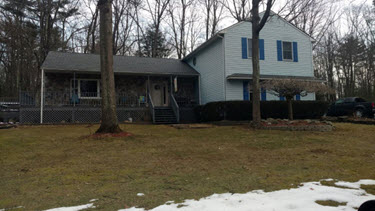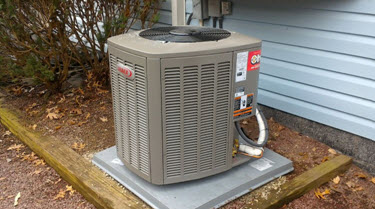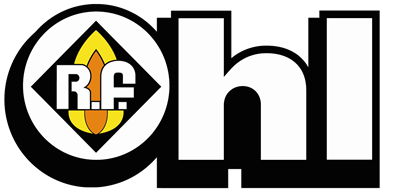Lehighton PA Homeowner Saves Money With New HVAC System
 Our homeowners in Lehighton PA came home to a problem: There was water leaking from the ceiling. At first, they thought there was a leak in the roof. But, it turned out to be an HVAC problem.
Our homeowners in Lehighton PA came home to a problem: There was water leaking from the ceiling. At first, they thought there was a leak in the roof. But, it turned out to be an HVAC problem.
What happened was that their air conditioning system had a clog in the drainage line. Over time, condensation builds up when it should have been draining away. Eventually, it built up in the drain pan.
This buildup caused two major problems: First, the leak. When the drain pan finally overflowed, the water began collecting on the floor of the attic. Eventually, it seeped down and started leaking through the ceiling.
Then, the buildup up ruined the ac itself. The water backed up into the system, causing it to short out. When we got to it, the unit needed replacement.
It all made more a very frustrating situation for our homeowners: It was the middle of the summer, and suddenly they had no air conditioning. And, they also needed to do some minor home repairs.
Fortunately, we were able to make the best of a bad situation. While we weren’t able to save our homeowner’s old system, we made sure they’d save money on a new one. And, we installed some extra items to prevent this problem from happening again.
Problem: A 20-year-old heat pump and air conditioner condenser in Lehighton PA needed replacement. It broke down, causing some damage to the house.
Solution: Installed a new Lennox air conditioning condenser with a Goliath secondary drain pan and safety switch.
What Caused An Overflow Of Water In The Air Conditioner?
 Put simply, water that naturally collects in an air conditioner didn’t drain properly. Part of the air conditioning process is removing humidity from the air. That humidity, of course, is moisture. And, it has to go somewhere.
Put simply, water that naturally collects in an air conditioner didn’t drain properly. Part of the air conditioning process is removing humidity from the air. That humidity, of course, is moisture. And, it has to go somewhere.
When the ac is working correctly, the humidity turns from gas back into the liquid inside the condenser. Then, a condensate line gets rid of it. That’s where the problem arose here.
What’s supposed to happen is that the moisture drips from the unit into a drainage pan. From there, it empties into a drain line. That line removes the liquid just like the pipe below your sink or shower.
In this case, however, something went wrong: The drain line clogged. This happens from time to time. Debris, dust, and dirt can collect in the pan and eventually travel down the line.
When it builds up, the water can’t get through. At that point, it starts building up in the drain pan. And, after a while, it will rise to the level of the unit and then overflow.
That’s what we found when we inspected this unit. It was located in the attic, and the drain pan was full. It was also dirty.
When we took the drain line apart, we could see all the blockage in it. All that dirt and debris from the pan made its way in there. Eventually, the water couldn’t pass through.
How Can I Prevent A Clogged Condensate Line?
Fortunately, it’s fairly easy to prevent in the drain line or condensate line. The first step is regular maintenance. After that, you can opt for a few accessories that will help prevent overflow.
Most HVAC experts recommend getting your cooling system inspected once a year. It’s a good idea to have a professional look it over before you fire it up for the season.
For starters, a tech will swap out any worn-down parts. This way, they’re out before they break down and cause a costly repair. And, they can identify problems like clogged drain lines early on.
If you’re handy, you can also handle some of the maintenance yourself. This includes some minor cleaning and checking the drainage. However, having an expert look it over is still the safer bet.
We also took some more steps to ensure this homeowner wouldn’t have this problem again. They came in the form of extra items that we included with his new model.
First was a Goliath secondary drain pan. Secondary drain pans are a regular item for condensers. But, this is one is a bit of a specialty item.
It’s more durable than the average model, for starters. And, it’s easier to adjust when we install it. This feature helps ensure proper drainage. Finally, it has rolled edges and no seams. The design prevents debris from building up or water from collecting where it shouldn’t.
We also included a safety switch for the drain pan. Also known as a float switch, this acts as a fail-safe. It sits in the drain pan and rises with the water level.
If the line clogs again, the water level in the drain plan will go up. Now, when it reaches a certain point, the switch will shut off the system. The homeowners will know to check it out or call us.
How Does A High-Efficiency Air Conditioner Save Me Money?
A high-efficiency air conditioner costs less to run than older models or those that aren’t as efficient. In this case, the efficiency with regards to how much energy, specifically electricity, the unit needs to run.
The more electricity an ac uses, the less efficient. More efficient models can provide the same amount of cooling as other models, but with less power. And, when you use less electricity, of course, you pay less on your electric bill.
Since our homeowners needed a new ac, we helped them pick one that would lower their energy bills. Their previous condenser was 20 years old, so finding one that would work better wouldn’t be that difficult. Still, we made sure to get one that made a big difference.
The Lennox model our homeowners settled on had a 16 SEER rating. That stands for “Seasonal Energy Efficiency Ratio.” Basically, it measures how much energy the system uses. The higher the number, the less power it needs.
A rating of 16 means it’s very efficient. A model needs just a 14 to earn a federal Energy Star rating. This rating means it meets government guidelines proving it uses less energy than comparable units.
With a 16 rating and extra features, our homeowners are in a much better position than before their old ac broke down. Sure, they weren’t planning on overhauling their HVAC set up. But, they were able to improve their situation when they did.
And, it won’t even impact their finances too heavily. Thanks to our financing options, they only pay $77 a month. That, coupled with the lower energy bills and peace of mind, seems worth the money.
If you are looking to explore ways to save money on your heating bills or have a problem with your current system, give us a call here at RF Ohl. We have the experience and the know how to make sure you are comfortable in your home, every day of the year, and save money at the same time.
